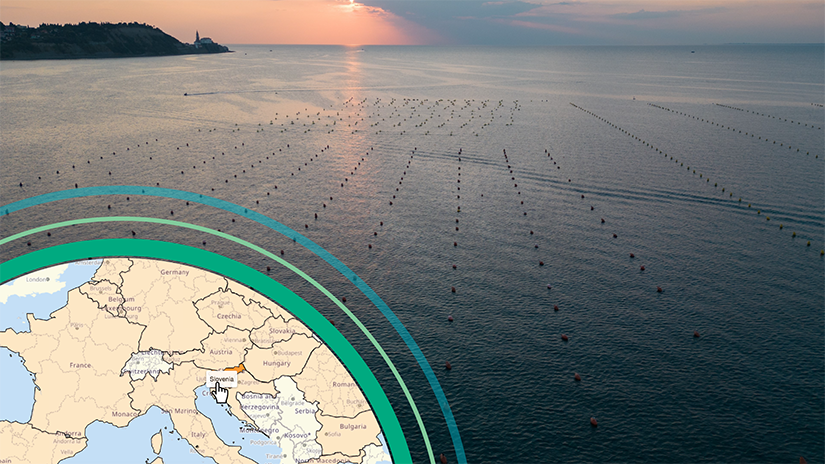Background information

Tipul de specie de crescătorie
Păstrăv curcubeu (Oncorhynchus mykiss), păstrăv brun (Salmo trutta), crap-de-mare (Cyprinus carpio), pește-de-mare de apă dulce (Clarias gariepinus), biban-de-mare european (Dicentrarchus labrax), Gilthead (Sparus aurata) și midii mediteraneene (Mytilus galloprovincialis), Warty venus (Venus verrucosa).
Sursă: 2023, EUMOFA; 2022, CSTEP, Slovenia, personal, 17 ianuarie 2023
Tipul metodei de producție
Cu acces direct la mare (aproximativ 46 km de coastă), acvacultura constă în acvacultură marină (30 %) și de apă dulce (70 %). Potrivit Eurostar, în 2021 au fost utilizate următoarele metode principale de producție:
Dimensiunea sectorului (producție și consum)
Sursă: 2023, EUMOFA; 2020, Republica Slovenia, Oficiul de Statistică
Tendințe (trecute și viitoare)
Creșterea competitivității și a sustenabilității acvaculturii, precum și îmbunătățirea eficienței energetice a acestor instalații.
Sursă: MNSPA
Impactul acvaculturii asupra economiei țării, a pieței alimentare și a pieței forței de muncă
Consumul anual de pește pe cap de locuitor ca autosuficiență în Slovenia este cu mult sub media Uniunii Europene.
Sursă: MNSPA
Provocări și oportunități
- Putere de capital scăzută a sectorului.
- Inovarea și cercetarea în domeniul acvaculturii.
- Aspecte legate de schimbările climatice și biodiversitate.
- Performanța de mediu a acvaculturii.
- Productivitate scăzută.
- Optimizarea și scurtarea procedurilor administrative.
- Amenajarea armonizată a teritoriului prin includerea spațiului pentru activitățile de acvacultură, în special creșterea crustaceelor și moluștelor, prin reverificarea compatibilității acvaculturii cu alte activități și prin evaluarea impactului asupra mediului.
- Informații și trasabilitatea produselor de acvacultură.
- Sensibilizarea consumatorilor cu privire la beneficiile alimentelor cultivate pe plan intern.
- Asigurarea dezvoltării în continuare și promovarea unei mai mari competitivități a sectorului acvaculturii.
- Introducerea unor forme ecologice de acvacultură va duce, de asemenea, la un consens social bazat pe acceptabilitatea ecologică a acestei activități economice.
- Asigurarea unor produse de calitate, sănătoase și proaspete, în principal de la producția internă, prin asigurarea trasabilității și a controlului de la locul de creștere până la farfurie.
- Digitalizarea va aduce o contribuție importantă la scurtarea procedurilor de autorizare pentru acvacultură.
Sursă: MNSPA
Ocuparea forței de muncă și numărul de întreprinderi
Numărul de persoane angajate în acvacultură în 2020 a fost de 181, dintre care 90 angajați cu normă întreagă.
Sursă: Oficiul de Statistică, MNSPA
Multi-annual National Strategic Plans for the development of sustainable Aquaculture
Relevant Authorities
Applicable Legislation
Applicable Procedures
- Dreptul la apă (inclusiv autorizațiile de utilizare a apei pentru cultivarea organismelor acvatice)
- Evaluarea impactului asupra mediului sau raportul de mediu
- Permis special de cultivare a speciilor exotice de organisme acvatice
- Registrul instalațiilor de acvacultură și al iazurilor comerciale și registrele unităților de producție de acvacultură autorizate (Registrul central al instalațiilor de acvacultură și al iazurilor comerciale) (CRA)
National associations and networks
- Camera de Agricultură și Silvicultură din Slovenia
- Asociația crescătorilor de animale acvatice din Slovenia
Relevant Websites
Contact Details
Ministerul Agriculturii, Pădurilor și Alimentației, Sectorul Pescuitului
Borut Kosi, consilier
- Număr de telefon: + 386 1 478 9370
